|
By John Pint
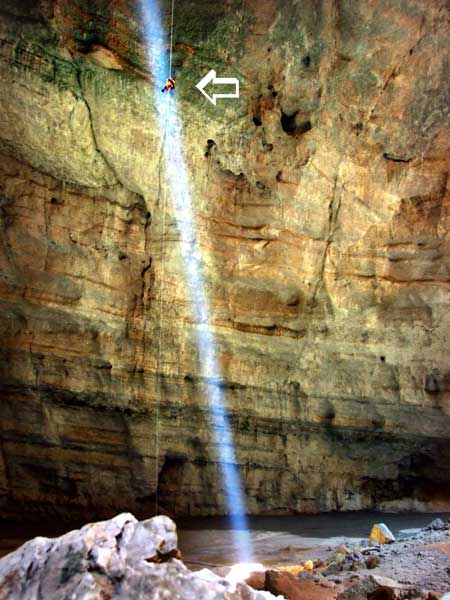 Recently,
I was given a golden opportunity to visit one of the world’s
natural wonders, Majlis al Jinn Cave in Oman: the largest sunlit
subterranean chamber in the world, big enough to hold a dozen
jumbo jets parked wing to wing or to completely swallow up the
Great Pyramid of Giza. Recently,
I was given a golden opportunity to visit one of the world’s
natural wonders, Majlis al Jinn Cave in Oman: the largest sunlit
subterranean chamber in the world, big enough to hold a dozen
jumbo jets parked wing to wing or to completely swallow up the
Great Pyramid of Giza.
How did I end up in Oman? It all started several months ago with
a telephone call that woke me up at 5 AM in Mexico. It also woke my wife
Susy, who usually answers the phone. “It’s for you,” she
mumbled, to my surprise. “It’s from a man named Siddarth in
Oman.”
“I have been looking all over the internet for somebody who
knows about desert caves and I keep finding your name,” said a
voice with a decidedly Indian lilt.
So it was I became consultant to a group of Canadian architects
who are actually from India but who happen to be working in
Oman. They needed the help of cave scientists to lay plans for
transforming Majlis Al Jinn into a tourist cave and I happened
to know just the people who could do that job with ease.
So I began working with Siddarth’s organization to prepare a
plan for turning this unique cave into one of the world’s most
unusual tourist attractions. They warned me that the Omani
government might want to meet with us on short notice, so I kept
a suitcase packed and ready to go, but I have to admit I was not
quite prepared for another one of those 5 AM calls. “John, the
board has set a date for our presentation. We’ve booked your
flight to Oman and your plane leaves Guadalajara in seven
hours.”
Flight to Oman
No sooner did I get on the plane than I began to miss Mexico. I
was flying on a U.S. carrier to Houston and once we were in the
air, I was handed something which the stewardess assured me was
a “sandwich.” Well, I admit the outside of it was shaped like a
bun, but it was a “bun” that had both the consistency and taste
of dry rubber. I then investigated the inside of it and found
two substances which had all the charm and flavor of cardboard.
Now I only mention this rubber-and-cardboard sandwich in order
to contrast it with the first meal I got on Qatar Airways later
in the day, as I sped toward the Middle East. The contents of
this meal were actually listed on a beautifully printed menu
and, among other things, featured honey-glazed chicken with
papaya as one of the main-course choices, served with several
choices of French wines (free, of course), with chocolate layer
fudge cake for desert. I was served two of these gourmet meals
during my eleven-hour flight and the amazing thing was that I
was flying economy class. Dare I add that even the complementary
chocolate was by Godiva?
Well fed, I landed in Muscat, capital of Oman, at the same time
an ancient and modern city of shimmering white buildings and
wide roads. Here, craggy, weathered limestone cliffs meet the
deep blue waters of the Arabian Sea and here resides the Sultan
of Oman, ruler of a large country with a population of only
three million nationals plus a modest amount of oil.
 “The
Sultan is dedicated to improving the lives of all his subjects,”
Omani geologist Salim Al-Maskery told me as we raced down the
coastal four-lane expressway toward the cave I needed to visit.
“He’s built roads to the most remote corners of the Sultanate,
wherever there’s a handful of people to be found,” continued
Salim, “and there he installs power lines and builds a school, a
clinic and a mosque.” “The
Sultan is dedicated to improving the lives of all his subjects,”
Omani geologist Salim Al-Maskery told me as we raced down the
coastal four-lane expressway toward the cave I needed to visit.
“He’s built roads to the most remote corners of the Sultanate,
wherever there’s a handful of people to be found,” continued
Salim, “and there he installs power lines and builds a school, a
clinic and a mosque.”
Only a few hours south of Muscat, we came to just such a road
and I could immediately appreciate just how difficult highway
engineering must be in Oman. We were at sea level and needed to
get up to the top of the Selma Plateau, 1345 meters straight up
from the beach. This meant that the two-lane dirt road we were
on was—I thought—just about as steep as a road could possibly
be. How wrong I was about that!
Up, up, up we went, the wheels of our brand-new 4WD vehicles
frequently slipping as the ever-twisting road took us toward our
goal. The rocky cliffs on both sides of us were stark and bare,
but frequently dotted with cave entrances. As we had spotted
numerous outcrops of limestone karst along this rising road, it
was hard to say whether those caves are only in the prevailing
marly limestone or whether some might be in the harder rock. It
looks to me like there are enough caves in this area to keep
speleologists busy for a long time.
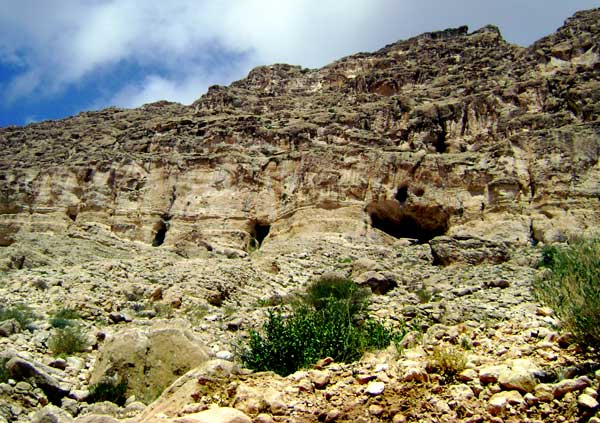
Countless caves can be seen on the way to the Selma Plateau.
At last we reached the flat top of the Selma Plateau and drove
right up to the edge of a huge, gaping black hole. “This is one
of the three entrances to Majlis Al Jinn Cave,” announced Salim,
“and we have a legend about where these holes came from.”
Wrath of the One-Eyed Genie
The geologist then explained that a woman named Selma supposedly
lived here a long, long time ago and somehow or other got on the
wrong side of a gigantic, one-eyed Jinn (Genie). Well, Selma
decided to run for her life and as she zigzagged across this
plateau, the Genie threw several thunderbolts at her. Luckily
for Selma, the Genie’s depth perception was pretty awful, having
only one eye and all, and three of those lightning bolts went
astray, each one of them leaving a humongous scar in the earth.
Of course, only in modern times was it verified that the three
holes are, in fact, skylights at the top of a single enormous
chamber. On June 23, 1983, American geologist Don Davison Jr.
rappelled to the floor of this cave and discovered to his
amazement that he was standing in a single room 340 meters long
by 228 wide with a 120 meter ceiling. As Davis later wrote (in
AramcoWorld Magazine), “The
Superdome in New Orleans—with a seating capacity of 97,365—could
easily be contained within the cavern's volume, with room for a
1600-car parking lot besides.”
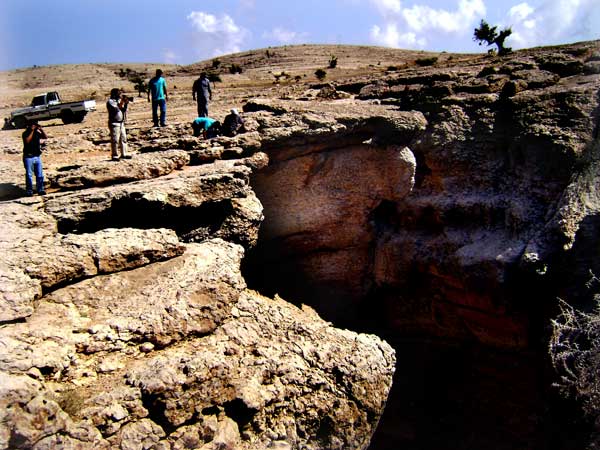
The Entrance to First Drop, 118 meters deep.
But it is not just size that makes this underground chamber
unique. Over the years, bigger underground rooms have been
found, however, it appears that none of the others feature the
spectacular light shows that explorers have witnessed inside
this cave in Oman, where beams of sunlight cut through the inky
blackness like the legendary bolts of the one-eyed Genie.
I was able to witness this phenomenon many years ago—on a
smaller scale—in Saudi Arabia’s
Dharb Al Najem
Cave which is 100 meters wide and 100 meters high, with a
small skylight at the very top. I rappelled down this narrow
opening, imagining this would be the size of the cave all the
way to the bottom, but a few meters lower, the walls fell away
and there I was, suspended like a spider on a thread above a
giant chamber, dramatically lit by a single long sunbeam.
It is this unique and unforgettable sensation that the Omanis
would like to share with members of the world community. The
idea is to put visitors inside a transparent Viewing Car
suspended at the end of a steel cable. The car is slowly lowered
through the skylight and down into the megachamber. Once on the
bottom, visitors could stroll along the walking path, admiring
the play of sunbeams streaming into the cave through the
skylights and constantly in motion.
Less adventurous visitors could descend a stairway through
centrally located Cheryl’s Drop (named after Cheryl Jones, wife
of Don Davison and the second person to rappel into the cave) to
a viewing platform suspended from the ceiling.
The Easier Road
Near the entrances to the three drops we found dozens of bolts
placed there by abseilers from all around the world who came to
experience this unique cave. Along with them came Base Jumpers
as well and finally the hullaballoo around the cave entrances
became so great that the government simply forbade any further
descents.
After a delicious picnic lunch, we headed
for home. “We’ll take a different route on the way back,”
announced Salim. “It’s longer, but a much better road.”
Half an hour later we were heading down a track that appeared
less and less like a road and more and more like a dry riverbed.
Finally it was nothing but a riverbed with a bizarre floor of
the vuggiest rock (meaning full of holes) I have ever seen.
Salim explained that such rock is ideal for holding oil, “just
like a sponge.”
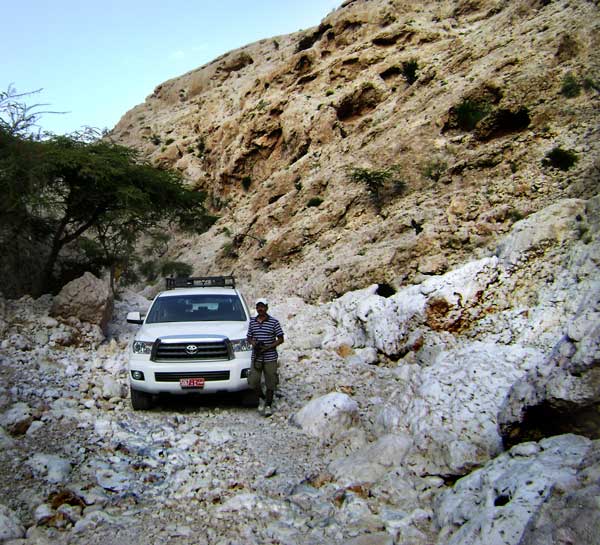
Fortunately, that rough arroyo eventually turned back into a
road and we soon passed a little village which was impressively
clean. When I asked what the local people live on, I was told
that they raise goats, and that, in Oman, one goat might fetch
the owner more than 250 Riyals ($649 US).
Now we were climbing and in a few minutes we came to the edge of
a cliff with a tremendous view. My GPS said we were 900 meters
high but straight down below us we could see the coast of the
Arabian Sea. We could also see the road that was going to take
us down to the bottom and it was even more vertical than the one
we had followed on the way up!
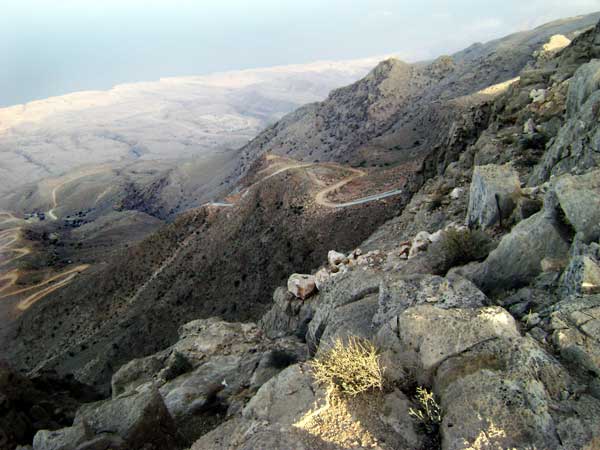
Well, we started creeping down that continually twisting road in
4WD-low and I must admit nowhere in the world had I ever seen a
road so steep. Later I sent the above picture to Louise Hose,
who wrote back saying she had been down the same road and at a
certain point the car she was in had rolled over, stopping just
at the edge of the drop …just one more “near death” experience
for Louise.
If Majlis Al Jinn is turned into a tourist cave, it will offer
visitors the experience of a lifetime, an experience I think
neither Disneyland nor Imax could ever hope to duplicate. And if
that doesn’t make an impression on them, I guarantee they’ll
never forget the incredible roads connecting the beach to the
Selma Plateau. Without a doubt, Majlis Al Jinn is surely going
to lure tourists to Oman from the farthest corners of the globe.

This is Oman! |



